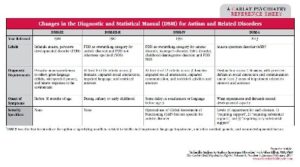Home » From Infantile Autism to Autism Spectrum Disorder
From Infantile Autism to Autism Spectrum Disorder

January 1, 2017
From The Carlat Child Psychiatry Report
Glen Elliott, MD, PhD
Editor-in-chief, The Carlat Child Psychiatry Report
Dr. Elliott has disclosed that he has no relevant financial or other interests in any commercial companies pertaining to this educational activity.
Changes in diagnostic criteria not only affect the clinical and public perception of a disorder, but also its perceived prevalence. Such is the case with autism. The evolution of the autism diagnosis since it was introduced into the Diagnostic and Statistical Manual (DSM) in 1980 inarguably has altered its reported prevalence, rising from an estimated 1 in 2,000 in 1980 to 1 in 68 in 2015 (https://www.cdc.gov/media/releases/2014/p0327-autism-spectrum-disorder.htm). Below is a rundown of key DSM changes for autism and related disorders. These are summarized in the accompanying table.
DSM-III
DSM-III, published in 1980, was the first edition to include what was labeled “infantile autism.” This diagnosis required all of the following:
DSM-III-R
DSM-III-R, published in 1987, made several changes, including categorizing autistic disorder as a subtype of pervasive developmental disorder (PDD). By considering symptoms present in older individuals and eliminating the requirement of onset before 30 months of age, it expanded the definition of autism considerably. The new diagnosis of autistic disorder still had an age requirement but now was defined on the basis of meeting at least 8 of a total of 16 criteria divided into 3 domains.
Especially influential was the broadening of criteria regarding communication, which included, for example, an absence of imaginative play and inability to sustain a social conversation. DSM-III-R also introduced the diagnosis of pervasive developmental disorder, not otherwise specified (PDD NOS), which could be applied if patients met some criteria but not enough to meet a diagnosis of autistic disorder.
DSM-IV
DSM-IV, published in 1994, retained the diagnosis of autistic disorder introduced in DSM-III-R and kept the same domains of impairment. It further de-emphasized age of onset by requiring only some symptoms before 3 years of age, not the full syndrome. The total number of criteria dropped to 12, with 4 in each domain; patients had to meet 6 criteria in total. A diagnosis of autistic disorder required:
DSM-IV also expanded the number of disorders included under PDD, adding Asperger’s disorder, Rett’s disorder, and childhood disintegrative disorder. The criteria for autistic disorder and Asperger’s disorder opened the door for a significant expansion in the number of individuals qualifying for a diagnosis. Research trying to establish whether autistic disorder and Asperger’s disorder differed in major ways other than language met with equivocal results.
DSM-IV offered no specific measurement of severity of autistic disorder, but clinicians could use the Global Assessment of Function (GAF) to describe overall impairment.
DSM-5
DSM-5, published in 2013, introduced more major changes in the approach to diagnosing autism. The umbrella diagnosis of PDD was dropped, and autism spectrum disorder (ASD) replaced autistic disorder. Two diagnoses previously included under PDD—Rett’s disorder and childhood disintegrative disorder—were omitted from DSM-5 altogether, the former because it is a well-defined genetic disorder and the latter because of its extremely low prevalence. Autistic disorder, Asperger’s disorder, and PDD NOS were consolidated into ASD. Further, emphasis changed to 2 domains: a) impaired social interaction and communication and b) odd behaviors, and the deficits were explicitly described as “illustrative, not exhaustive,” differing from the early practice of defining criteria explicitly. Thus, a diagnosis of ASD requires:
DSM-5 introduced modifiers to the diagnosis, so clinicians specify intellectual impairment, language impairment, and other medical, genetic, and neurodevelopmental factors. Further, for patients with language problems who did not meet criteria for ASD, a new diagnosis of social (pragmatic) communication disorder was introduced, similar to the old Asperger’s disorder. Finally, for individuals with ASD, DSM-5 created a 3-point severity scale for each domain: Level 1, “requiring support”; Level 2, “requiring substantial support”; and Level 3, “requiring very substantial support.”
Child PsychiatryDSM-III
DSM-III, published in 1980, was the first edition to include what was labeled “infantile autism.” This diagnosis required all of the following:
- Onset before 30 months of age
- Pervasive lack of responsiveness to other people
- Gross deficits in language development
- Peculiar speech patterns such as immediate and delayed echolalia
- Bizarre responses to various aspects of the environment
- These criteria would include only a small fraction of people with a current diagnosis of ASD—mostly younger individuals with significant cognitive impairments.
DSM-III-R
DSM-III-R, published in 1987, made several changes, including categorizing autistic disorder as a subtype of pervasive developmental disorder (PDD). By considering symptoms present in older individuals and eliminating the requirement of onset before 30 months of age, it expanded the definition of autism considerably. The new diagnosis of autistic disorder still had an age requirement but now was defined on the basis of meeting at least 8 of a total of 16 criteria divided into 3 domains.
- Onset during infancy or childhood
- Qualitative impairment in reciprocal social interactions, at least 2 of 5 criteria
- Qualitative impairment in verbal and nonverbal communication, at least 1 of 6 criteria
- A markedly restricted range of activities and interests, at least 1 of 5 criteria
Especially influential was the broadening of criteria regarding communication, which included, for example, an absence of imaginative play and inability to sustain a social conversation. DSM-III-R also introduced the diagnosis of pervasive developmental disorder, not otherwise specified (PDD NOS), which could be applied if patients met some criteria but not enough to meet a diagnosis of autistic disorder.
DSM-IV
DSM-IV, published in 1994, retained the diagnosis of autistic disorder introduced in DSM-III-R and kept the same domains of impairment. It further de-emphasized age of onset by requiring only some symptoms before 3 years of age, not the full syndrome. The total number of criteria dropped to 12, with 4 in each domain; patients had to meet 6 criteria in total. A diagnosis of autistic disorder required:
- Delays before 3 years of age in at least one of the following areas: social interaction, language used for social communication, or symbolic or imaginative play
- Qualitative impairment in reciprocal social interactions, at least 2 of 4 criteria
- Qualitative impairment in communication, at least 1 of 4 criteria
- A restricted range of activities and interests, at least 1 of 4 criteria
DSM-IV also expanded the number of disorders included under PDD, adding Asperger’s disorder, Rett’s disorder, and childhood disintegrative disorder. The criteria for autistic disorder and Asperger’s disorder opened the door for a significant expansion in the number of individuals qualifying for a diagnosis. Research trying to establish whether autistic disorder and Asperger’s disorder differed in major ways other than language met with equivocal results.
DSM-IV offered no specific measurement of severity of autistic disorder, but clinicians could use the Global Assessment of Function (GAF) to describe overall impairment.
DSM-5
DSM-5, published in 2013, introduced more major changes in the approach to diagnosing autism. The umbrella diagnosis of PDD was dropped, and autism spectrum disorder (ASD) replaced autistic disorder. Two diagnoses previously included under PDD—Rett’s disorder and childhood disintegrative disorder—were omitted from DSM-5 altogether, the former because it is a well-defined genetic disorder and the latter because of its extremely low prevalence. Autistic disorder, Asperger’s disorder, and PDD NOS were consolidated into ASD. Further, emphasis changed to 2 domains: a) impaired social interaction and communication and b) odd behaviors, and the deficits were explicitly described as “illustrative, not exhaustive,” differing from the early practice of defining criteria explicitly. Thus, a diagnosis of ASD requires:
- Symptoms early in development that may not manifest until social demands exceed capacity and may be masked later in life through learned strategies
- Persistent deficits in social communication and social interaction, with 3 “illustrations” (as opposed to specific criteria) such as poor socio-emotional reciprocity, impaired nonverbal communication, and difficulties developing and maintaining relationships
- A restricted range of activities and interests, with at least 2 areas of impairment, such as stereotyped motor movements, insistence on sameness, highly restricted interests, and either excessive or markedly diminished reactions to sensory input, similar to the 4 “illustrations” provided
DSM-5 introduced modifiers to the diagnosis, so clinicians specify intellectual impairment, language impairment, and other medical, genetic, and neurodevelopmental factors. Further, for patients with language problems who did not meet criteria for ASD, a new diagnosis of social (pragmatic) communication disorder was introduced, similar to the old Asperger’s disorder. Finally, for individuals with ASD, DSM-5 created a 3-point severity scale for each domain: Level 1, “requiring support”; Level 2, “requiring substantial support”; and Level 3, “requiring very substantial support.”
Table: Changes in the Diagnostic and Statistical Manual (DSM) for Autism and Related Disorders
(Click here to view as full-size PDF)
Issue Date: January 1, 2017
Table Of Contents
Recommended
Newsletters
Please see our Terms and Conditions, Privacy Policy, Subscription Agreement, Use of Cookies, and Hardware/Software Requirements to view our website.
© 2025 Carlat Publishing, LLC and Affiliates, All Rights Reserved.



_-The-Breakthrough-Antipsychotic-That-Could-Change-Everything.webp?t=1729528747)



